Diabetic Ketoacidosis (DKA)
Diabetic Ketoacidosis (DKA). Dr. Reem Sallam , MD, MSc, PhD Clinical Chemistry Unit, Pathology Dept. College of Medicine, King Saud University. Diabetic emergencies. Diabetic Ketoacidosis (DKA) Hyperosmolar hyperglycaemic state (HHS)= Hypperosmolar non- ketotic acidosis (HONK)
Share Presentation
Embed Code
Link
Download Presentation
- acetyl coa
- elderly patients
- phd clinical chemistry unit
- hepatocyte mitochondria
- hco3-
- severe illness e

ozzy + Follow
Download Presentation
Diabetic Ketoacidosis (DKA)
An Image/Link below is provided (as is) to download presentation Download Policy: Content on the Website is provided to you AS IS for your information and personal use and may not be sold / licensed / shared on other websites without getting consent from its author. Content is provided to you AS IS for your information and personal use only. Download presentation by click this link. While downloading, if for some reason you are not able to download a presentation, the publisher may have deleted the file from their server. During download, if you can't get a presentation, the file might be deleted by the publisher.
Presentation Transcript
- Diabetic Ketoacidosis (DKA) Dr. ReemSallam, MD, MSc, PhD Clinical Chemistry Unit, Pathology Dept. College of Medicine, King Saud University
- Diabetic emergencies • Diabetic Ketoacidosis (DKA) • Hyperosmolar hyperglycaemic state (HHS)= Hypperosmolar non-ketotic acidosis (HONK) • Hypoglycemia
- Diabetic Ketoacidosis (DKA)
- Diabetic Ketoacidosis (DKA): • Triad of hyperglycemia, high anion gap metabolic acidosis, and ketonemia • Characteristically associated with T1DM • It has become increasingly common in T2DM • DKA may be the first presentation of T1DM
- Ketone Bodies • Acetoacetate • Acetone • β-Hydroxybutyrate • They are produced by the liver (ketogenesis) and utilized for energy production by peripheral tissues (Ketolysis)
- Normally, glucose is the primary fuel for the brain. It can penetrate the blood brain barrier. The brain’s GLUT is insulin-independent. If glucose is not available for the brain, the brain can utilize plasma ketone bodies, that can penetrate the blood brain barrier, and serve as fuel molecules.
- Ketone bodies synthesis = Ketogenesis • Occurs in the hepatocyte mitochondria • In uncontrolled DM there is ↑lipolysis in adipose tissue ↑[FFA] mobilization to liver ↑hepatic FA oxidation ↑ acetyl CoA which will be channeled into KB synthesis • HMG CoA synthaseis the rate limiting enzyme • The first KB to be synthesized is acetoacetate. • Acetoacetate can be: • reduced to β-Hydroxybutyrate, or • spontaneously decarboxylated to acetone.
- Ketogenesis • ↑hepatic FA oxidation ↑ acetyl CoA which will be channeled into KB synthesis • Acetyl CoA + oxaloacetate (OAA) Krebs cycle • ↑ Acetyl CoA production activates pyruvatecarboxylase • Pyruvatecarboxylase converts pyruvic acid into OAA • OAA is used for gluconeogenesis (rather than Krebs cycle) • Acetyl CoA is channeled into KB synthesis
- Ketone Bodies Utilization=Ketolysis • Takes place in extrahepatic tissues • Occurs in the mitochondria (so cannot occur in RBCs) • Does not occur in the liver (as the liver lacks the thiophoraseenzyme required for ketolysis) • β-Hydroxybutyrate is oxidized to acetoacetate (by a dehydrogenase) • Acetoacetate is converted to acetoacetyl CoA (catalyzed by thiophorase) • Acetoacetyl CoA is converted to acetyl CoAs.
- Ketone Bodies Utilization=Ketolysis
- Mechanisms of DKA: In uncontrolled DM there is ↑lipolysis in adipose tissue ↑ [FFA] ↑ mobilization of FFA to liver ↑hepatic FA oxidation ↑ hepatic acetyl CoA which will be utilized in KB synthesis (ketogenesis) ketoacidosis
- Mechanisms & Manifestations of DKA • In uncontrolled DM the rate of ketogenesis is > the rate of ketolysis ketonemia (↑[KB] in blood) ketonuria (↑[KB] in urine). • Manifestations of DKA: • Fruity odor on the breath (acetone) • Acidosis (low pH of blood because KBs are acids) • Dehydration (due to glucosuria)
- Precipitating factors for DKA • Infection (30-40%) • Inadequate insulin treatment or non-compliance (20%) • Severe illness e.g., Myocardial infarction • Trauma • Drugs: e.g., steroids
- Hyperosmolar hyperglycaemic state (HHS)= Hypperosmolar non-ketotic acidosis (HONK)
- Hyperosmolar hyperglycaemic state (HHS)= Hypperosmolarnon-ketotic acidosis (HONK • Little or no accumulation of ketone bodies • Serum [glucose] is often >50 mmol/L • Plasma osmolality may reach 380 mosmol/Kg (normal 275-295) • Neurological abnormalities are frequently present • Insulin levels are insufficient to allow appropriate glucose utilization but are adequate to prevent lipolysis and subsequent ketogenesis • Usually occurs in elderly patients with T2DM • Has a substantially higher mortality than DKA (up to 15%)
- Hypoglycemia
- Hypoglycemia: • Common complication of treatment with insulin or oral hypoglycaemics • More common in patients with T1DM • Characterized by: • CNS Symptoms (confusion, aberrant behavior, or coma) • Low blood [Glucose] • Symptoms resolved within minutes following the administration of glucose
- Hypoglycemia is a medical emergency, Why ? • The brain has absolute requirement for a continuous supply of glucose • Transient hypoglycemia cerebral dysfunction • Severe, prolonged hypoglycemia brain death
- Hypoglycemia, continued.. • Hypoglycemia occurs due to impaired protective responses to hypoglycemia: • Insulin is supplied exogenously and its release cannot be turned off • Glucagon & adrenaline response to hypoglycemia becomes impaired later in the course of DM • Clinical presentation: • Symptoms of sympathetic overactivity(plasma [glucose]
- Hormonal mechanisms to prevent or correct hypoglycemia: ↓ Production of insulin • ↑production of: • - Epinephrine & glucagon • - Growth hormone • - Cortisol
- Glycemic thresholds for the various responses to hypoglycemia:
- A CASE of DKA • A 14-year-old girl was admitted to a children’s hospital in coma. Her mother stated that the girl had been in good health until approximately 2 weeks previously, when she developed a sore throat and moderate fever. She subsequently lost her appetite and generally did not feel well.
- A CASE of DKA …………Cont’d • Several days before admission she began to complain of undue thirst and also started to get up several times during the night to urinate. However, on the day of admission the girl had started to vomit, had become drowsy and difficult to arouse, and accordingly had been brought to the emergency department.
- A CASE of KDA, continues.. On examination: • She was dehydrated • Her skin was cold • She was breathing in a deep sighing manner (Kussmaul respiration) • Her breath had a fruity odor • Her blood pressure was 90/60 mmHg (N: 120/80) • Her pulse rate 115/min. • She could not be aroused A provisional diagnosis of T1DM with complicating ketoacidosis and coma (DKA) was made by the intern on duty
- Laboratory findings: blood results The admitting diagnosis was confirmed by the laboratory findings shown below:
- Laboratory findings : blood results, continued.. *Anion gap (A-)= (Na+ + K+)– (HCO3- + Cl-)
- Laboratory findings: Urine results
- Interpretation of Laboratory findings
- Metabolic Changes in DM and DKA Multiple effects • Lipid metabolism • lypolysis • fatty acid oxidation • production of Ketone bodies • K+, Water & pH • entry of K+ into the cells • Water loss secondary to glycosuria • Acidosis due to production of ketone bodies • CHO metabolism • glucose uptake by certain tissues (adipose tissue & muscle) • glycogenolysis • gluconeogenesis • Protein metabolism • protein synthesis • protein degradation DKA DM
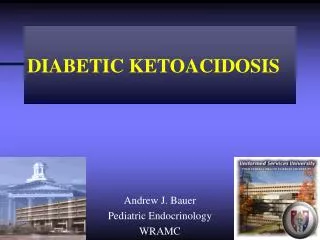
DIABETIC KETOACIDOSIS
DIABETIC KETOACIDOSIS. Andrew J. Bauer Pediatric Endocrinology WRAMC. GOALS. REVIEW TYPE 1 DIABETES AND METABOLISM AS THEY RELATES TO DKA. CLINICAL DIAGNOSIS and MISLEADING LABS TREATMENT and CONTROVERSIES TREATMENT GUIDELINES. Type 1 DM.
2.21k views • 59 slides

Diabetic Ketoacidosis
Diabetic Ketoacidosis. Abdelaziz Elamin Professor of Pediatric Endocrinology University of Khartoum, Sudan. Introduction. DKA is a serious acute complications of Diabetes Mellitus. It carries significant risk of death and/or morbidity especially with delayed treatment.
5.03k views • 33 slides
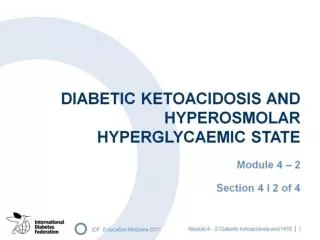
DIABETIC KETOACIDOSIS AND HYPEROSMOLAR HYPERGLYCAEMIC STATE
DIABETIC KETOACIDOSIS AND HYPEROSMOLAR HYPERGLYCAEMIC STATE. Objectives. What is diabetes ketoacidosis (DKA)?. DKA - Incidence . DKA - Precipitating factors. DKA - Development. Ketones. Ketones. DKA - Early clinical symptoms and signs. DKA - Later clinical symptoms and signs.
1.34k views • 45 slides
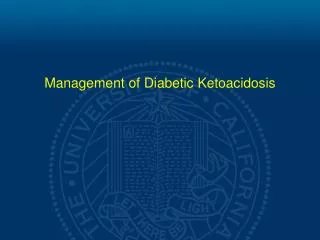
Management of Diabetic Ketoacidosis
Management of Diabetic Ketoacidosis. Objectives. Management of DKA: 1) Fluids 2) Insulin 3) Electrolyte replacement. Management: Fluids. Glucose osmotic diuresis causes dehydration Give between 4-6 liters, then reassess (caution in CHF) Fluids help decrease the blood glucose levels
602 views • 23 slides

Diabetic Ketoacidosis
Diabetic Ketoacidosis. Michele Ritter, M.D. Argy Resident – February, 2007. Diabetic Ketoacidosis (DKA).
835 views • 18 slides

Diabetic Ketoacidosis
Diabetic Ketoacidosis. DefinitionPathophysiologyClinical manifestationsTreatmentcomplications. Diabetic Ketoacidosis. DKA is the end result of the metabolic abnormalities resulting from a severe deficiency of insulin or insulin effectiveness, stress hormone excess.DKA occurs in 20 ? 40 % of new
726 views • 25 slides
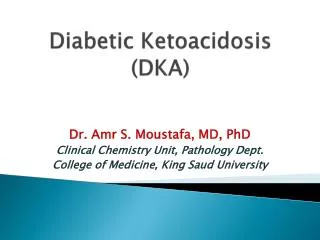
Diabetic Ketoacidosis (DKA)
Diabetic Ketoacidosis (DKA). Dr. Amr S. Moustafa, MD, PhD Clinical Chemistry Unit, Pathology Dept. College of Medicine, King Saud University. Diabetic emergencies. Diabetic Ketoacidosis (DKA) Hyperosmolar hyperglycaemic state (HHS)= Hypperosmolar non- ketotic acidosis (HONK)
1.28k views • 29 slides

Management of Diabetic Ketoacidosis
Management of Diabetic Ketoacidosis. Done by: Mohammed S. Samannodi MBBS, ID demonstrator. Definition. DKA is life threatening complication of DM, occur predominantly in type1 DM but it can occu in those with type2 DM.
681 views • 13 slides
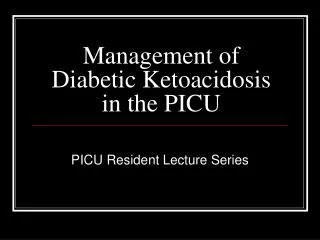
Management of Diabetic Ketoacidosis in the PICU
Management of Diabetic Ketoacidosis in the PICU. PICU Resident Lecture Series. DKA - A common PICU diagnosis. Incidence 4.6 – 8 per 1000 person years among people with diabetes Pediatric mortality rate is 1-2%. DKA causes profound dehydration. Hyperglycemia leads to osmotic diuresis
584 views • 21 slides
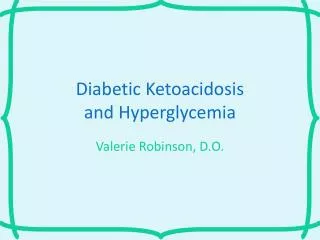
Diabetic Ketoacidosis and Hyperglycemia
Diabetic Ketoacidosis and Hyperglycemia. Valerie Robinson, D.O. Hyperglycemia. Type 1 DM, Type 2 DM, G estational Diabetes May present with polyuria, polydipsia, weight loss May present with DKA
473 views • 17 slides
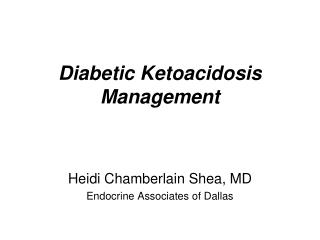
Diabetic Ketoacidosis Management
Diabetic Ketoacidosis Management. Heidi Chamberlain Shea, MD Endocrine Associates of Dallas. Goals of Discussion. Pathophysiology of DKA Biochemical criteria for DKA Treatment of DKA Prevention of DKA Hyperosmolar Nonketoic Syndrome. Epidemiology. Annual incidence in U.S.
1.01k views • 36 slides

Diabetic Ketoacidosis
Diabetic Ketoacidosis. Goals & Objectives. Understand the action of insulin on the metabolism of carbohydrates, protein, and fat Understand the pathophysiology of IDDM and DKA Understand the management approach to the patient with DKA
1.12k views • 39 slides

Paediatric Diabetic Ketoacidosis
Paediatric Diabetic Ketoacidosis. Scary Statistics. DKA = most common cause of death in children with IDDM. 25% of children newly diagnosed with DM1 present in DKA 15% in serious clinical status. All DKA admissions after diagnosis are avoidable! Costly direct and indirect. Management.
507 views • 23 slides
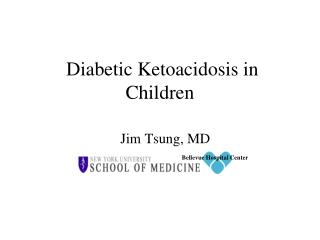
Diabetic Ketoacidosis in Children
Diabetic Ketoacidosis in Children. Jim Tsung, MD. Bellevue Hospital Center. DKA. Is the most common cause of hospitalization of children with diabetes Is the most common cause of death in children with diabetes Is fatal in <1% (from 1-2% of children in the 1970’s)
1.62k views • 34 slides
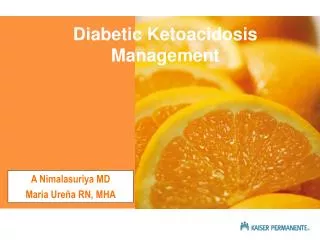
Diabetic Ketoacidosis Management
A Nimalasuriya MD Maria Ureña RN, MHA. Diabetic Ketoacidosis Management. Goals of Discussion. Pathophysiology of DKA Biochemical criteria for DKA Treatment of DKA Prevention of DKA Hyperosmolar Nonketoic Syndrome. Epidemiology. Annual incidence in U.S. 5-8 per 1000 diabetic subjects
1.22k views • 33 slides

Diabetic Ketoacidosis (DKA) & Hyperglycemic Hyperosmolar State (HHS)
Diabetic Ketoacidosis (DKA) & Hyperglycemic Hyperosmolar State (HHS). Ulrich K. Schubart, MD JMC/AECOM. DKA/HHS Presenting Symptoms. Nausea and Vomiting Polyuria and Polydipsia Weakness and/or Anorexia Abdominal Pain Visual Disturbances Somnolence. DKA/HHS Presenting Signs. Tachycardia
2.04k views • 36 slides

Diabetic Ketoacidosis
Diabetic Ketoacidosis. Gary David Goulin, MD. Goals & Objectives. Understand the action of insulin on the metabolism of carbohydrates, protein, and fat Understand the pathophysiology of IDDM and DKA Understand the management approach to the patient with DKA
680 views • 39 slides

Diabetic Ketoacidosis
Diabetic Ketoacidosis. Definition. 2009 ADA consensus statement on DKA Life-threatening condition characterized by hyperglycemia (glucose >250mg/dl) Ketonemia or ketonuria Arterial pH <7.3 Bicarb < 15mmol/L. Epidemiology/Statistics. Annual incidence 5-8 episodes/1000 person-years
1.18k views • 34 slides

DIABETIC KETOACIDOSIS
DIABETIC KETOACIDOSIS. PRESENTED BY: SIMI M PAUL PEDIA WARD. DEMOGRAFIC DATA Name : case no: 4 MR no : 157203 Diagnosis : DKA (Diabetic ketoacidosis) Age : 13 years Gender : Female Date of admission: 09/10/2012
1.02k views • 23 slides

DIABETIC KETOACIDOSIS AND HYPEROSMOLAR HYPERGLYCAEMIC STATE
DIABETIC KETOACIDOSIS AND HYPEROSMOLAR HYPERGLYCAEMIC STATE. Objectives. What is diabetes ketoacidosis (DKA)?. DKA - Incidence. DKA - Precipitating factors. DKA - Development. Ketones. Ketones. DKA - Early clinical symptoms and signs. DKA - Later clinical symptoms and signs.
1.19k views • 45 slides

Chemistry Presentation: Diabetic Ketoacidosis
Chemistry Presentation: Diabetic Ketoacidosis. BY: Leor Surilov. Table of Contents. What is Diabetic Ketoacidosis (DKA)? Biochemistry of DKA Complications/symptoms of DKA Why is this important to discuss? How is this related to chemistry? Conclusion. WHAT is Diabetic Ketoacidosis (DKA).
174 views • 12 slides

Management of diabetic ketoacidosis (DKA)
Management of diabetic ketoacidosis (DKA). Prof. M.Alhummayyd. Diabetic ketoacidosis. Acute emergency that requires admission to hospital. It develops as a result of insulin deficiency. Insulin deficiency. ↑ glycogenolysis ↑ gluconeogenesis, ↑ protein catabolism. ↑ Lipolysis. ↓. ↓.
594 views • 11 slides
























